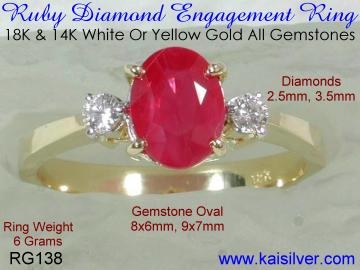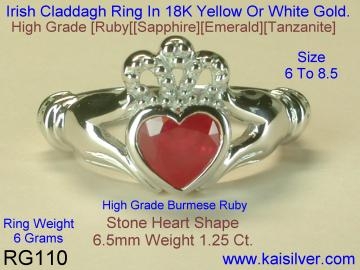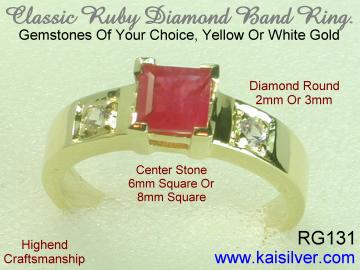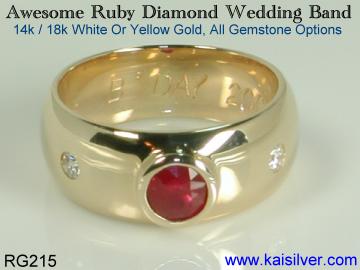When choosing a gem stone rings, make sure that the jeweler gives you complete information related to the gem stones in the rings. We have come across several cases where the buyer received gems that were not as expected or not as per the price value of the ring. This can happen to both gold and sterling silver rings. On this web page we discuss important issues related to gems, make sure that you understand the information. The idea is to give you a fair and good chance of evaluating your jeweler before you make a purchase. If you are ever confused or need further regarding any particular gem stone, do not hestitate to email us at sales@kaisilver.com we will be glad to answer all your queries. You are never under any obligation to make a purchase so do take full advantage of our expertise and honesty.

RG138
This Kaisilver ruby diamond ring has good durability and craftsmanship. The ring in 14k or 18k white or yellow gold with a good grade 8x6mm center ruby and 2.5mm diamonds is in the 1,500 U.S$ to 1,700 U.S$ price range. ... more.
The Ruby gemstone is a gorgeous red corrundum and belongs to the same family as the sapphire. The finest rubies come from Burma although these mines have now depleted the best quality of rubies for which they were famous. The US trade embargo on Burmese rubies has sent the gem stone industry on a trail for new ruby deposites. Mozambique rubies from the African continent have emerged as a fairly large source for ruby gems today. Indian rubies are of a very low quality and have almost no transparency, it is probably the geographical terrain that give the Indian rubies a flaky kind of appearance. The durability of these rubies is not very good and various oils are used to enhance the appearance of the Indian ruby.
Like all other gemstones you get natural and artificial rubies. Kaisilver provides a very simple explanation for gem stone lovers. All rubies that are mined from the earth are natural, the rest of the 'rubies' are artificial or manmade. Clever gem stone manufacturers are for ever playing gimmicks on innocent buyers. They have managed to classify artificial rubies as lab created and synthetic. A lab created ruby is one where the chemical composition of the natural ruby has been incorporated into the factory made ruby. So such rubies besides looking like real rubies also mimic the properties of the gem stone. Synthetic rubies are an interesting issue. They include everything from plastics, resins and glass that have the color of the natural ruby. Such imitation or synthetic rubies mimic only the external appearance of the ruby and not the chemical composition of the natural stone.
So which of these ruby types is good? It is obvious that a ruby ring with a natural ruby gem stone would be ideal. But the price of such gems especially in the medium to good quality grades can be quite stiff. This might push some ruby ring buyers to consider lab created or synthetic rubies. Manmade rubies will look gorgeous since they are made in a controlled environment and should be void of cracks, inclusions and fissures something that, comes almost always with natural rubies. Let us do a little price factor analysis here. A medium grade 2 carat natural ruby could be priced at around 500 U.S$ for the piece. A lab created ruby of the same size and better appearance would be priced at around 20 U.S$ for the piece. A synthetic piece of glass or resin with the ruby color, would be priced at around 10 U.S$ for the piece. We are ofcourse talking about retail prices for a single piece or few pieces.
So if you would like to consider a synthetic or lab created stone for your silver or gold ruby ring, do so by all means. Just make sure that you pay for what you are getting. The saddest part is when a jeweler talks a buyer into paying extravagant prices for cheap mass produced factory junk. We do hope that the above information will reduce the chances of innocent buyers being cheated by smart talking jewelers.
Natural rubies have impressive physical properties. The type of treatment used for the gem in your ruby ring could affect the durability of the stone, this is explained in the next column. Let us explain the properties for a conventionally heat treated ruby gemstone. Ruby has a good hardness factor of 9 on the Mohs scale. This is very good considering the fact that only 1 gemstone is harder than this and it is the diamond. The color of the stone is stable, it will not fade in light or heat. Color stability is an important feature that defines the value of a gem. Most household items like soaps, water and cooking oils do not affect rubies. This means that the durability of your ruby ring is good.
The Ruby is the July birthstone, and represents the Cancer zodiac symbol. It is also regarded as the gem stone for Tuesday. For an anniversary, you would choose a ruby for the 15th, 40th and 80th anniversaries.
For many centuries, the ruby has been believed to symbolize love and devotion. It is also supposed to bring wealth and enhance self esteem. Many historical 'ruby jewels' turned out to be red spinel, some were infact rubelite (a variety of tourmaline). Ruby mining has today begun in many other locations. This is being done to cope with the U.S ban on Burmese rubies.
Another interesting thing that we need to discuss about is the treatment for rubies. These are processes used by gem stone manufacturers to enhance the appearance (and price) of natural rubies. Almost 95% of the rubies that are used in the gems and jewelry industry are treated in some way or the other. So you will be right in presuming that the gem in your ruby ring is treated. The important thing is to understand the type of treatment used. Some treatments affect the durability of the stone, they could also reduce the value of the ruby.
The conventional process to treat rubies is the normal heating process. This decades old treatment is still practised. Gemological experts accept this treatment as long as no chemicals or foreign substances are added into the ovens during the heating process. The ruby being treated in this case needs to have a fairly good quality, the treatment cannot drastically improve the appearance of the ruby. And this defined the limitations of the normal heating process used to treat ruby gems. It will be fine if your silver or gold ruby gem stone ring uses a gem that has passed through this treatment.
Gem manufacturers were aware of the fact that the starting rubies for conventional heat treatment, needed to have a fairly good quality. They tried to devices new treatments where even, lower quality rubies could be altered to deliver good looking ruby gemstones. The first commercially implemented new heat treatment could technically be referred to as the 'borax' heat treatment. In this case borax or chemicals similar to borax were added to the oven during the heating process. The borax helped reduce the melting point of the ruby (corrundum). This melting ruby then flowed into the natural cracks and fissures in the gemstone. The closing of the fractures increased the clarity and transparency of the gem stones. Gemologists and gemological labs discovered this process several months after gem manufacturers started implementing it! Today clear tests have been developed to identify rubies that have been treated in this way.
Having managed to improve the appearance of medium grade and normal grade rubies, gem manufacturers turned their attention to junk rubies. These are rubies that are so bad in quality that they show more of purple and white (in the rough form) rather than red. In normal circumstances the miner never even bothers to take this junk out of the mine, it is left in the ruby mines. They finally got success in what is today popularly known as the 'glass filled rubies' process. Some top television sales gimmicks refer to these rubies as 'fissure filled rubies'.
Let us explain this process in detail here. The starting point for the glass filled rubies is the worst quality ruby gems. They would normally be discarded or not mined at all. The rubies are first soaked in a strong acid solution. This increases the porosity of the ruby and also makes it very brittle. The gems become so brittle that pressing them firmly on a table with your thumb can cause them to crumble! These soaked rubies are then washed clean and allowed to dry. The chemicals for the oven are carefully prepared and include silica based salts. The rubies along with the chemicals are put in small crucibles which are tightly sealed using white cement or similar substance. The crucibles are heated in the even for several hours, in some cases the heating process is repeated several times. The silical salts are transformed into molten glass, this fills up the pores in the rubies. On cooling the rough ruby appears to have good color and transparency. It is actually the presence of glass that holds the brittle (almost falling apart) rough ruby pieces together. These glass filled rubies are then cut and polished. The problem is that these rubies are not strong, they show the properties of ordinary glass rather than the precious ruby. Strong detergents or solvents and even ultrasonic cleaners can ruin glass filled rubies.
It is important to have a good idea of the pricing structure of rubies going through various treatments. They are all stones that started out as natural rubies. A 2 carat normal heat treated ruby in a medium grade quality can cost you around 400 U.S$ to 600 U.S$ for the piece. When it comes to the borax heat treatment, the durability of the gem is not negatively affected by the treatment, the stone would sell at around 100 U.S$ to 200 U.S$ for the piece.
To the untrained eye, a ruby gem stone ring with the glass filled ruby might appear the best. But it is also the cheapest since, it is a composite stone that includes ruby and glass. The process drastically reduces the durability of the ruby too. This gemstone in 2 to 3 carat sizes should be priced at around 10 U.S$ to 25 U.S$. All of these are ofcourse retail prices for small quantity purchases. The best way to ensure that you get good value for your money is to carefully evaluate and choose the right jewelry or gem stone provider. It is just not possible for a casual buyer to evaluate all features and properties of the ruby that he is getting.

RG110
The best rendition of the historic claddagh ring. Kaisilver creates the finest rendition of this 375 year old jewel. Avaialble as yellow or white gold claddagh rings, all gem stone options. Price range for the ruby ring is in the 1,700 U.S$ to 2,100 U.S$ range. ... more.

MAN50
An awesome mens ruby gem stone ring. This mens ruby ring has an 7mm round ruby gem stone, you can choose from 2 grades. Available as an 18k or 14k ruby mens gold ring, the choice of yellow or white gold ruby rings is also available. A price range of just 2,500 U.S$ to 3,000 U.S$ for this impressive ruby ring ... more.

RG131
A streamlined ruby wedding ring, can also be made as a ruby wedding band. The center square ruby in this ring is 6mm to 7mm. Genuine round diamonds on the shoulders of this custom 14k or 18k ruby gem stone ring. This sturdy ruby gold ring is in the 1,900 U.S$ to 2,750 U.S$ price range ... more.

RG215
An ruby gem stone wedding band ring that is suitable for men or ladies. This ruby wedding ring is available in yellow or white gold. The sturdy ring is well supported by a healthy gold weight. This gem stone ring is in the 1,500 U.S$ to 2,300 U.S$ price range. ... more.
If you are shopping for a ruby gemstone ring, do not be put off by rubies that show inclusions. You obviously need not accept a rub gem that is filled with inclusions, and almost opaque. But low to medium amount of inclusions should be expected. After all rubies are natural gems that developed over millions of years. If you see a 1.5 carat and above ruby gem with absolutely no inclusions visible to the naked eye, take a good look at the stone. The gem if natural, could cost you a small fortune. It is more likely to be a manmade fake stone.
Avoid ruby rings with a cluster design, these are gemstone rings where several small gems are set close to each other. Such rings are well known to lose few gems after some amount of wear and tear. It might be difficult to replace lost stones that fell off since the color match with the existing gems will be critical.
When you choose the design for your yellow or white gold ruby gem stone ring, make sure that the gemstone mounting is firm and sturdy. Loose stones can fall off and could be very expensive to replace. It is not uncommon for these gem stone rings to have a gold cost component that is lower than the gem stone cost component.
When orderding your ruby gold ring from Kaisilver, remember that you have the option to choose the design, ruby gem stone grade, metal, yellow or white gold, ring size and overall dimensions of your gem stone ring. By providing you with an unmatched degree of customization prove that we are the leading global online custom made jewelry provider. You are welcome to send us your queries or doubts at sales@kaisilver.com Our team of professionals will come up with suggestions and advice that will guide you to make the right decision.